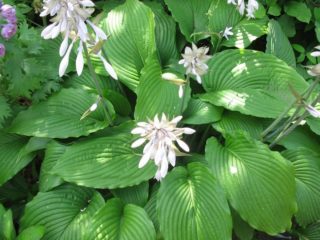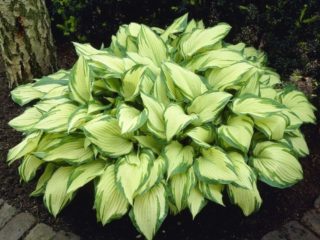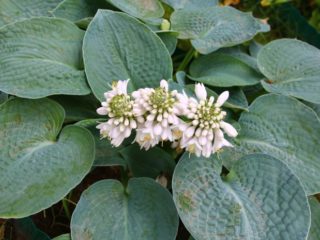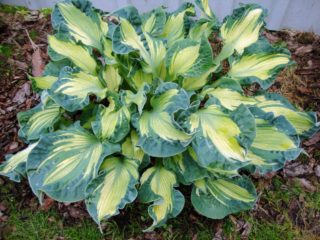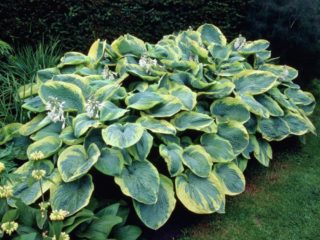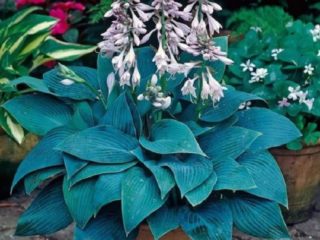Content
Many gardeners face difficulties when choosing plants for a shady area. Hosta Fest Frost is an excellent solution for this situation. This is an unusually beautiful deciduous bush that will be an ideal addition to a flower bed or flower garden.
Description of hosts Fest Frost
It is a compact deciduous plant. The height of the bush is up to 40 cm, and the width is 60-70 cm. At the same time, the length of the leaves can reach 14-16 cm. It grows best in partial shade; in the sun the color of the bush fades.
The leaves are very dense, dark green in color with a yellow border on the sides. In the spring, "Fest Frost" is brighter. Because of the coloring, it seems that the leaves are covered with frost, which is where the name of the described variety comes from.
Hostas "Fest Frost" have a medium spreading habit. They do not require garters or supports to give shape. The neat appearance is maintained until late autumn, until the leaves begin to fall from the bush.
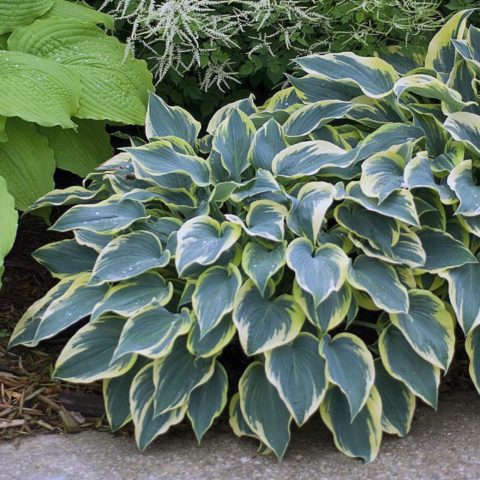
The plant has a beautiful border on the leaves; in early spring the border is yellow, in summer it is pale milky.
Hostas are not demanding on the composition and nutritional value of the soil. It can stay in one place for up to 20 years. In the future, a transplant is required.
Flowering occurs in late July - early August.During this period, the bush is covered with light lavender flowers. This is another important decorative property of the Fest Frost hosta. Flowering lasts on average 3 weeks.
The plant tolerates low temperatures well. Therefore, it is popular among gardeners from regions with different climatic conditions. Also, the Fest Frost variety is resistant to diseases and pests.
Application in landscape design
Hostas look good in flower beds and flower beds in combination with other ornamental plants. They are often used for framing or zoning areas, as well as for decorating artificial ponds, benches and other dacha structures.
Hostas are usually used to add fullness. Therefore, they are planted in places where there are few bright flowers. Hosta is suitable for multi-tiered flower beds and decorative compositions. "Fest Frost" goes well with other varieties.
Among them:
- Francis Williams.
- August.
- Golden Meadows.
- Vaid brim.
- Whirlwind.
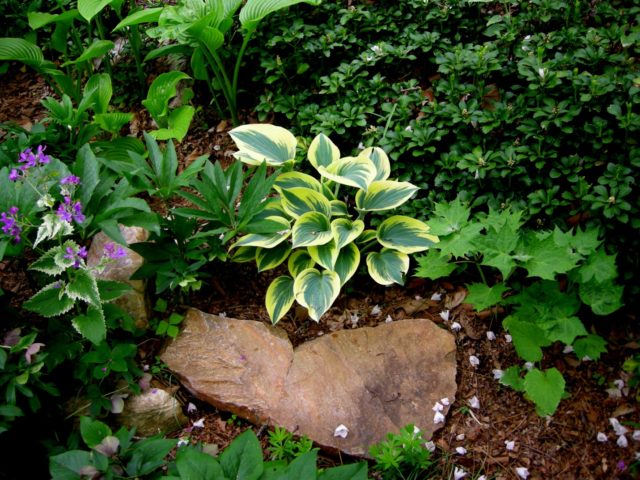
A flower can become either an independent green space or part of a beautiful composition.
Shade-loving hostas also pair well with lavenders, peonies, lilies, daylilies and gladioli. Representatives of the Fest Frost variety feel comfortable next to phloxes, lungworts and irises. Together, these plants can decorate any garden plot.
Hosta Fest Frost propagation methods
It is best to increase the number of bushes by cuttings. This procedure should be carried out in April-May, with persistent warming. It is necessary to select an adult plant and separate several young shoots from it. They are planted in a nutritious soil mixture of river sand, garden soil and peat. When the shoots sprout, they need to be transplanted to a permanent place.
Another proven propagation method is dividing the bush. It is very effective for Hosta Fest Frost, as it has a powerful root system.
Division algorithm:
- Dig around the bush from all sides.
- Remove it along with the roots.
- Clear underground shoots of soil.
- Rinse the roots in water and let dry for 2-3 hours.
- Divide the hosta into 2 or 3 parts.
- Move to a new location in compliance with planting technology.
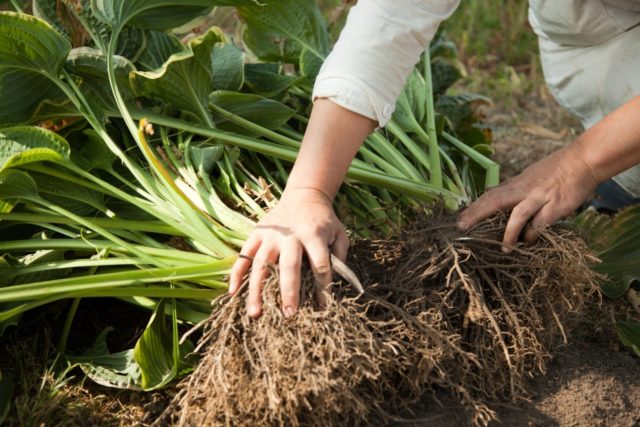
Dividing the root system is the most popular way to propagate hostas.
The hybrid hosta First Frost can be propagated using seeds. This is one of the few plant varieties that produces fertile seeds for planting. They are planted in April in a sterile soil mixture. Normally, seeds germinate after 2-3 weeks. They need to be placed in a place well lit by the sun. Transplantation into the ground is carried out 2 weeks after the appearance of ground shoots.
Landing algorithm
Hosta grows well in all types of soil. It is best to plant in a mixture of humus, clay and a small amount of sand.
Planting is recommended in the spring season. When the last frost has passed, you need to prepare the soil. At the selected location, dig a hole 20-30 cm deep and 60 cm wide. This soil is fertilized with organic matter (compost, manure or droppings). You can use ready-made formulations, for example, Kemira-universal.
Landing method:
- Pour the prepared soil into the hole.
- Let it brew for 3-5 days.
- Dig a hole for the seedling.
- Add a drainage layer (if necessary).
- Place the seedling in the soil mixture so that the roots are at a depth of 5-6 cm from the surface.
- Sprinkle with loose soil.
- Water with a small amount of settled water.
- Sprinkle the surface of the seedling with mulch.

Hostas are shade-loving plants and do not tolerate direct sunlight.
It is not recommended to plant Hosta Fest Frost in the fall. The reason for this limitation is that the plant may not have time to take root before the onset of frost. The opposite picture is also possible. Due to warm weather, seedlings form shoots, which will certainly die in the future due to the cold. Therefore, it is better to plant in the spring.
Growing rules
In order for the Fest Frost bush to grow well, comprehensive care is required. Hostas are not among the most demanding plants, however, this does not mean that they do not need to be looked after.
"Fest Frost" is a moisture-loving variety. The plant may suffer due to lack of fluid, especially in dry summer weather. The fact that the hosta is experiencing water deficiency is indicated by darkening of the tips of the leaves. Excess liquid is also not recommended to prevent stagnation in the roots.
Each bush requires at least 10 liters of water, ideally 30 liters. Then the liquid will saturate the soil to a depth of 30-50 cm, providing nourishment to the roots.
For irrigation, you need to use settled water at room temperature. The frequency of the procedure depends on weather conditions. During drought, abundant watering should be done at least once a week.
To ensure the flow of nutrients, it is necessary to periodically fertilize.To do this, you should use a complex fertilizer made of organic and mineral components.
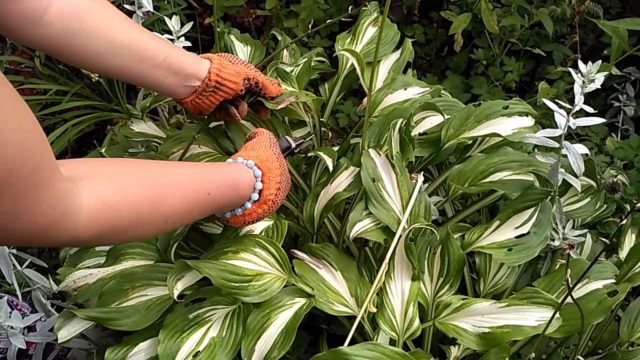
Periodically it is necessary to fertilize with organic matter
For 1 host you will need:
- cow manure – 10 l;
- ammonium nitrate – 10 g;
- superphosphate – 20 g;
- potassium sulfate – 10 g.
This mixture will provide the necessary nutrients. Fertilizing should be done in the spring when early shoots appear, after flowering has ended, and in late autumn when pruning.
Fertilizers can also be applied by mulching the soil. To do this, humus, crushed dry grass, bone meal, straw and peat are used. Mulching is carried out as the soil compacts 1-2 times a season.
General rules for growing hostas:
Preparing for winter
The Fest Frost variety tolerates cold well. But this does not mean that preparation for winter is optional. It begins in August or early September. During this period, you need to cut off all flower stalks so that the hosta does not waste nutrients on the formation of seeds.
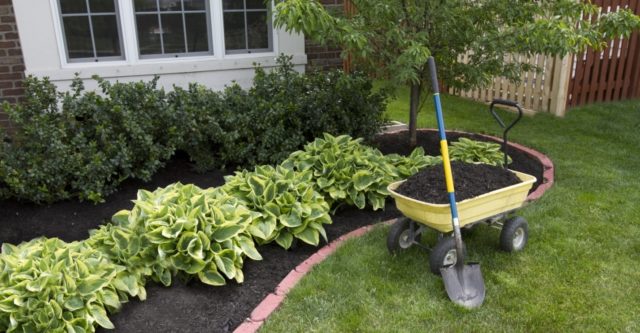
Despite the fact that the plant tolerates frost well, it still needs to be covered with spruce branches
After this procedure, fertilizer with phosphate and potassium is applied. In this case, the bush itself must be treated with a fungicide to prevent the appearance of pests.
In the fall, before the onset of cold weather, the soil at the base of the bush is mulched with humus, sawdust and mixed with peat. In winter they will protect the roots from the cold, and in the spring they will serve as additional fertilizer. It is recommended to add tobacco dust to the mulch, as it repels slugs.
Hosta "Fest Frost" is covered with light brushwood for the winter. Fir branches are best suited. They hold snow well, creating reliable protection for the bush.
There is no need to trim leaves on the Fest Frost hosta before winter. This procedure makes the plant weak. It is necessary to remove old leaves in the spring, when new shoots appear.
Diseases and pests
The Fest Frost variety is resistant to numerous diseases. However, in rare cases, the plant may suffer due to infections.
Among them:
- gray rot;
- phyllosticosis;
- rust.
These diseases affect the appearance of the leaves and lead to dehydration. Treatment consists of removing the affected areas and treating the bush with fungicides.
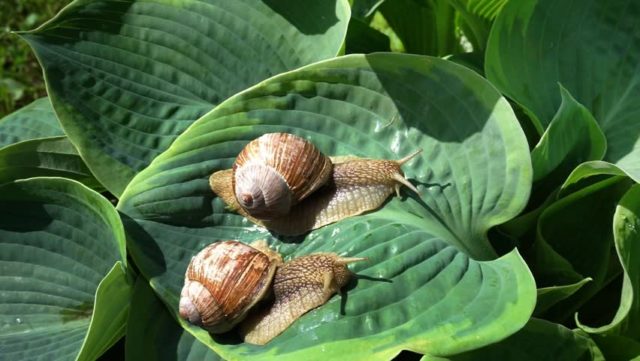
Snails are afraid of the smell of dill and garlic
Among the pests that pose a danger to hostas, slugs and snails. To combat them, special baits are used, which are placed in places far from the bushes. Solutions that repel pests are also used. Slugs are repelled by garlic, dill, roasted coffee beans and sage.
Conclusion
Hosta Fest Frost combines excellent decorative qualities, unpretentiousness and ease of cultivation. This variety goes well with other plants, so it is actively used to decorate flower beds and flower beds. Caring for bushes is not difficult, which is why hostas have become very popular. An important advantage is resistance to cold, pests and diseases, thanks to which the plant remains viable for a long period of time.
